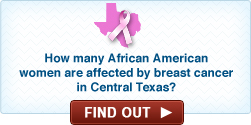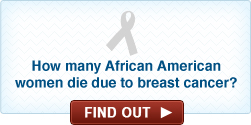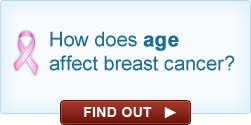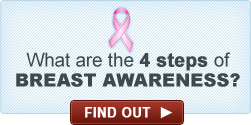Thirty years ago, many people were uncomfortable even uttering the terms “breast cancer” and “mammogram,” let alone discussing the need for early detection and treatment. Today, community-wide conversations and programs focused on maintaining breast health and surviving breast cancer are widespread, thanks to coordinated leadership on both the national and local level.
Nationally, the campaign to discuss breast cancer more openly began with a marketing symbol—a pink ribbon– and an annual fundraising event—a race. Over the years, the discussion has evolved from the tactile—a focus on self-exams—to a broader awareness of breast health. In Central Texas, the Austin Affiliate of Susan G. Komen for the Cure has delivered that national message to the local community through specific and targeted programs.
Keeping 75 percent of the proceeds from the race and other fundraisers in local hands, Komen Austin has led in the development of a collaborative effort—involving medical providers, researchers, policy makers and communities—to reduce breast cancer mortality in our five-county region. The remaining 25 percent of funds, sent to the national organization, is dedicated exclusively to research, with the results of that work coming back to 122 local affiliates to inform their ongoing efforts.
Since 1999 Komen Austin has invested $12.6 million in local breast health services and global research. $3.7 million has been directed to national research efforts, with $8.9 million granted to local entities that provide breast health-related services to uninsured, underinsured and underserved residents of Bastrop, Caldwell, Hays, Travis and Williamson counties. To ensure that our grants are directed where they are most needed, Komen Austin conducts a Community Profile Report, including both quantitative and qualitative data, every two years.
Following the Roadmap
The results of the most recent profile, conducted in 2011 and published in a report, serve as a roadmap to the effectiveness of the services we currently fund, and also identify the gaps—service areas where we can apply our leadership to soliciting RFPs, developing new programs or encouraging further collaboration among our existing providers.
Service gaps identified in the 2011 Community Profile Report include:
- An increase not only in the numbers of uninsured women, but also of under-insured women—those who have lost jobs, become self-employed or seen large increases in their insurance premiums and, as a result, have limited access to medical services.
- A disproportionate incidence and/or mortality rate in minority communities, particularly African-American and Hispanic women.
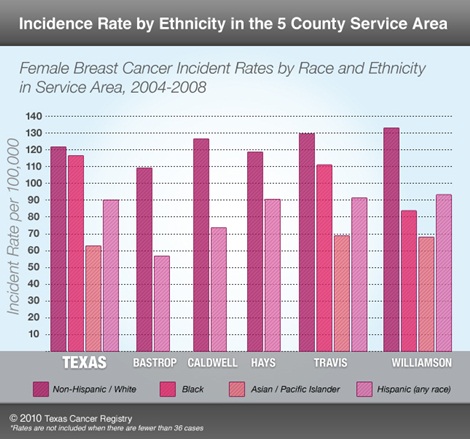
- The five-year relative survival rate for breast cancer diagnosed in 1996-2004 among African American women was 77 percent, compared to 90 percent among whites. Only about half (51 percent) of breast cancers diagnosed among African-American women are diagnosed at a local stage, compared to 62 percent among white women. Studies have documented unequal receipt of prompt, high-quality treatment for African-American women. There is also evidence that aggressive tumor characteristics are more common in African-Americans.

- Although the breast cancer incidence rate in Hispanic women is 27 percent lower than that in non-Hispanic white women, Hispanic women are 20 percent more likely to die from breast cancer than non-Hispanic white women diagnosed at a similar age and stage. This is a direct result of lack of access to care and treatment. Hispanics also represent the fastest-growing, and least likely to be insured, segment of the region’s population.
- Cultural issues within minority communities can discourage women from discussing breast cancer or pursuing care. Fear, modesty, religion and fatalism all play a part in holding women back from seeking early screenings that can improve their survival rates.
- High poverty rates and lack of breast health services in Bastrop and Caldwell counties, where the data continue to demonstrate the region’s highest poverty rates and the fewest breast health service providers.
- Barriers to screening remain consistent over time: lack of information/knowledge about early detection, lack of health insurance; fear of costs; concerns about family reactions; lack of transportation or high cost of gasoline; time off work for medical appointments and treatment; loss of income during treatment; financial obligations during diagnosis and treatment; and, even for insured women, numerous and costly co-payments.
Leadership at All Levels
Responding to the findings of the 2011 Community Profile, Komen Austin has launched several initiatives dedicated to increasing the awareness of breast health among minority communities. These programs, led by Harriet Choffel, Grants Director, and Monica Saavedra, Director of Mission Services, exemplify our approach to fill the gaps in areas where services are least available.
The Community Profile documents the disproportionate rates of cancer mortality among the African-American community, yet no local program existed specific to this community in Austin. Seeking to develop a program, Choffel approached Dr. Marylou Adams, a professor in UT’s School of Nursing, to extend her model African-American breast health education program. Choffel and Adams enlisted the Alliance for African-American Health in Central Texas to implement Dr. Adams’ model in Austin’s 78723 ZIP code. Komen Austin granted $48,977 to the Alliance to provide a continuum of breast health care and services to women in this predominantly African-American community.
The ‘Women in Strides’ program provides a critical extension of this service initiative. A peer-to-peer initiative, Women in Strides provides education and outreach specific to the cultural expectations and norms of the African-American community. The program is led by four African-American women, three of them breast cancer survivors, who have been trained to lead discussions and outreach efforts in their communities.
Continuing to Lead the Conversation
Thirty years after a pink ribbon kicked off a national conversation about breast cancer, we have come a long way in our understanding of breast cancer and ability to treat and prevent breast cancer mortality.
Since our founding, Komen Austin has translated that conversation into services for every corner of our community. As our region’s needs continue to grow because of a constrained economy, dramatic population growth and demographic shifts, it is more important than ever before for Komen Austin to create new ways to meet the needs of underserved women.
We are dedicated to leadership in every aspect of our organization and cultivating that leadership among Central Texans.





